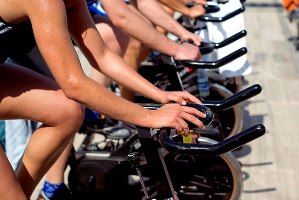One of my favorite workouts is cycling. When I discovered spin class, it became my drug. I loved how challenging it was and that it always left me dripping sweat by the end. Hundreds of calories torched, cardiovascular endurance, toned legs – what more could I ask for in an exercise? It was perfect workout, or so I thought.
According to a new study published in the Journal of Sexual Medicine, I should be concerned about the way biking is affecting my sexual health. Similar to the concern for males when it comes to biking, women might need to be concerned, too. This is because the way the bike seat is designed, it can cause body weight to rest on the front or ‘nose’ of the seat, putting pressure on nerves and blood vessels in the genital area.
This can raise the risk of erectile dysfunction in men, which is something that’s been proven in studies of male bicycle police officers. But understandably, female cyclists haven’t been studied as closely on the matter due to our, ahem, different make up. However, a study conducted at Yale in 2006 that compared female cyclist with runners concluded that cyclists have less genital sensation compared to female runners. Interesting.
However, a new study does bring more insight. Forty-eight women who bike at least 10 miles a week brought their personal bikes into a lab to be set up on stationary machines. The women positioned their seats and handlebars to their preference and were then monitored as they rode, reporting any numbness, tingling or pain they felt in the genital region. And sensation felt in the pelvic region was also being monitored by a device attached to their bikes.
What the study found was that the women with handlebars that sat lower than their seats experienced more pressure in the perineum – an area of soft tissue near the pelvis – and had decreased sensation in the pelvic region.
The researchers speculated that the lower the handlebars sat in relation to the saddle, the more it caused the women to lean forward and force more of their body weight onto the perineum. This is typically caused when a person leans forward and flattens their back to achieve a more aerodynamic position.
So what the findings are causing researchers to caution women against is this: Monitor the position of your handlebars and be aware of safe riding practices to reduce the risk of lost sensation in the genital region.
Health scientist Dr. Steven Schrader, who’d previous researched male police bikers in similar study, said that one of the best ways to reduce pressure in the genital region is to use a bicycle saddle that doesn’t have a nose. The findings from his study led Schrader to recommend that police offers should use ‘no nose’ saddles because they transfer pressure to the sit bones instead of the perineum. And although he hasn’t studied the effectiveness of this for women, he suspects it would be equally beneficial for them as well.
In the meantime, cyclists should be cautious and monitor the way their saddle is making them feel. And if you experience any numbness or tingling, consider raising your handlebars, getting a no nose saddle, or repositioning yourself to lean forward less and take pressure off the the front of your pelvis region. After all, your sexual health is on the line.
Also Read:
